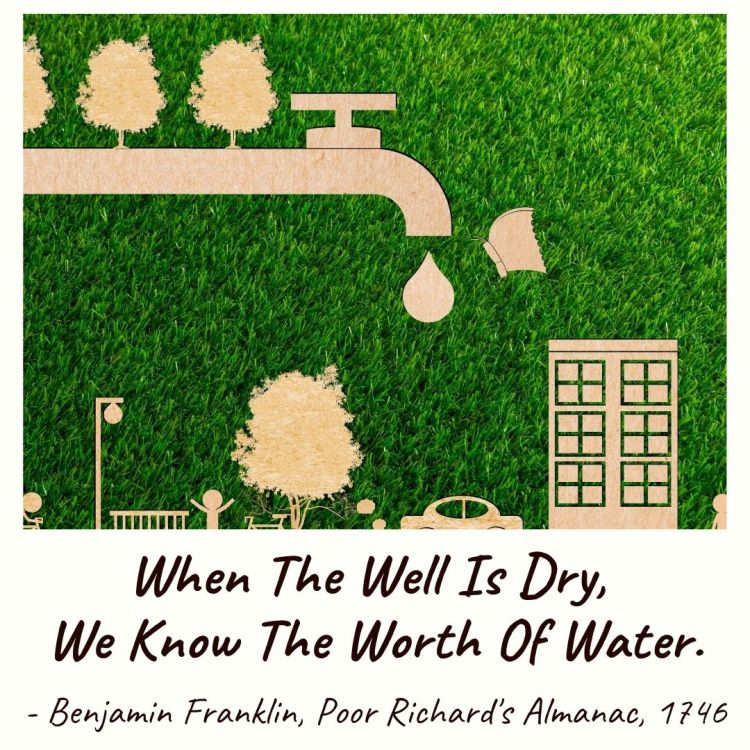Water Wisdom

Watering In Winter
Some people believe they don’t need to water their trees and plants during the winter. That couldn’t be further from the truth! Especially THIS winter.
Dry air, low precipitation, high winds, little soil moisture, and fluctuating temperatures are characteristics of this winter in many areas of West Texas. Midland is still currently under drought conditions. Trees, shrubs, perennials and lawns under these conditions may be damaged if they do not receive supplemental water.
- Water trees, shrubs, lawns, and perennials during prolonged dry winter periods to prevent root damage that affects the health of the entire plant.
- Established large trees have a root spread equal to or greater than the height of the tree. Apply water to the most critical part of the root zone within the dripline.
- Water trees less than two years old once a week during the winter.
- Make certain to have a good layer of mulch to protect roots of trees, shrubs and plant from the cold. Winter watering combined with mulching can prevent this damage.
The result of long, dry periods during winter can be injury to parts of plant root systems. Affected plants may appear perfectly normal and resume growth in the spring using stored food energy. But plants may be weakened and all or parts may die in late spring or summer when temperatures rise. Weakened plants also may be subject to insect and disease problems as plants are sensitive to drought injury.
Woody plants with shallow root systems require supplemental watering during extended dry fall and winter periods. Woody plants also benefit from mulch to conserve soil moisture.
Herbaceous perennials and ground covers in exposed sites are more subject to winter freezing and thawing. This opens cracks in soil that expose roots to cold and drying. Again, 3 to 4 inches of mulch is the best way to prevent this damage along with about half of the watering you do in the summer.
Lawns also are prone to winter damage. Newly established lawns, whether seeded or sodded, are especially susceptible. If it’s a particularly dry winter, water your lawn monthly,
Newly planted trees are most susceptible to winter drought injury. Trees generally take one year to establish for each inch of trunk diameter. For example, a two-inch diameter (caliper) tree takes a minimum of two years to establish under normal conditions.
Trees obtain water best when it can soak into the soil slowly to a depth of 12 inches. Apply water to many locations under the dripline and beyond if possible.
Newly planted shrubs require more water than established shrubs that have been planted for at least one year. Water within the dripline of the shrub and around the base.
Xeriscaping
Xeriscaping is a comprehensive approach to landscape design that accounts for microclimate and soil conditions on the site to create a sustainable solution. There are 7 basic principles to help you create a beautiful, sustainable landscape. To read more about how to apply these principles to your home, be sure to check out this article from National Geographic.
- Planning and Design
- Soil Analysis
- Practical Turf Areas
- Appropriate Plant Selection
- Efficient Irrigation
- Use of mulches
- Appropriate Maintenance
Water Wise Around The House
A few small changes can make a huge difference. By changing our habits and tweaking our actions, we can use water more efficiently, lower our costs, and keep our environment happy. Even though we are in the Permian Basin, when we save water, we can help to reduce pollutant and contaminant runoff into the ground and extend the life of our sewer or septic system.
- Inspect all pipes and faucets for leaks
- Check toilets for hidden leaks
- Install ultra-low volume toilets and low-flow showerheads
- Turn off the tap while shaving or brushing your teeth, and take shorter showers
- Load the automatic dishwasher and washing machine to capacity before running them
- Clean vegetables using water in a pan and a vegetable brush rather than letting the tap run
- Insulate your hot water pipes to waste less water before hot water flows
- Wash the car with soap, water, and a bucket; use a hose with a shut-off nozzle for a quick final rinse
- Use a broom to clean sidewalks or driveway, instead of washing them down with a hose
Water Wise Around The Yard
The greatest waste of water results from applying it too rapidly or too often to lawns and gardens. Water applied too rapidly is lost as runoff, which may carry polluting fertilizers and pesticides into streams and lakes. The cycle and soak method is best for reducing runoff and making sure your lawn and garden get the moisture it needs to thrive. For this method, water is applied in multiple shorter cycles. This allows the water to soak into the soil before running off, promoting deeper roots and healthier plants.
- Water lawns only when needed.
- Use native or adapted plants that do well on little water.
- Mulch plants to hold in moisture and limit weed growth
- Install efficient irrigation systems.
- Use drip irrigation systems for bedded plants.
- Water lawns during the early morning or evening hours.
- Never water on windy days.
- Make sure that sprinkler heads are properly adjusted to avoid watering sidewalks and driveways.
